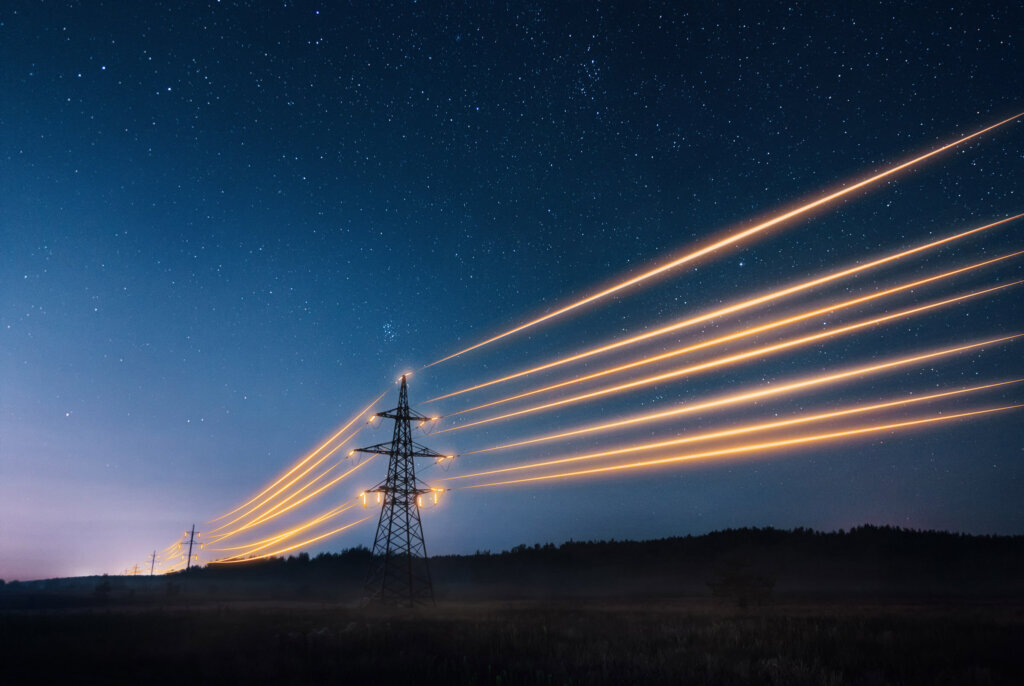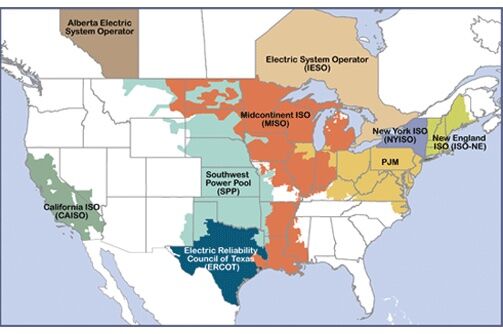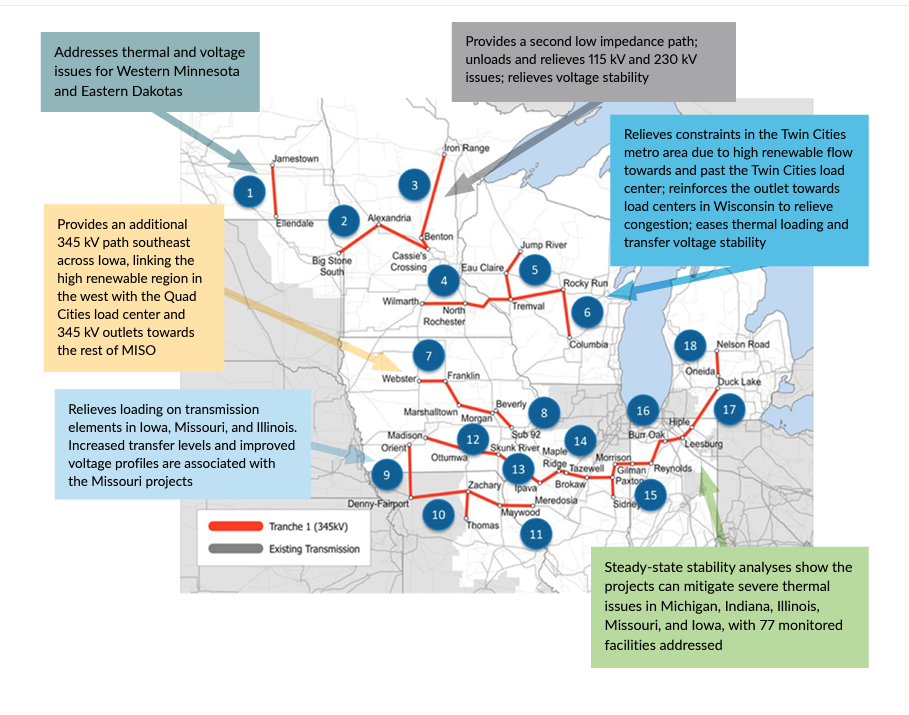This article was republished with permission from WTOP’s news partners at Maryland Matters. Sign up for Maryland Matters’ free email subscription today.
This content was republished with permission from WTOP’s news partners at Maryland Matters. Sign up for Maryland Matters’ free email subscription today.

For the better part of the past century, the American electric power system evolved around large, mostly fossil fuel power plants delivering electricity to residences, businesses and industry through a network of transmission and distribution wires that collectively came to be called the electric grid.
But as the threat of climate change driven by carbon pollution becomes more dire and as technological advances make wind, solar and battery storage ever cheaper options for powering homes and business, states, corporations and voters are increasingly pushing to aggressively decarbonize the grid.
Power generation resulted in more than 1.7 billion tons of carbon dioxide emissions in 2020, according to the U.S. Energy Information Administration, and accounted for about a quarter of all U.S. carbon emissions. Transportation contributes another 27%, and policies to speed up electric vehicle adoption, including in the recently passed Inflation Reduction Act, rely on the electricity needed to charge all those battery-powered cars being produced cleanly.
Thirty states, including Maryland, and Washington, D.C., have active renewable or clean energy requirements, and three other states have voluntary renewable energy goals, per the National Conference of State Legislatures. And major corporations — from Amazon, Target and Microsoft to Boeing and Google — are also increasingly becoming major green power consumers.
That collective momentum has led to a flood of renewable energy development — thousands of projects, billions of dollars in capital and thousands of jobs — but getting that electricity to customers is more complicated than just building solar panels and wind turbines.
Millions of American electric customers are in territories managed by entities called regional transmission organizations or independent system operators, which are tasked with managing the flow of electricity across the grid, running electric markets, ensuring reliability and overseeing new interconnections.
And while grid operators say they’re doing their best to manage the renewable transition while ensuring reliability and keeping costs stable, critics contend they’ve been caught flatfooted and are only just now coming to grips with the new demands of a changing power system on their markets and interconnection queues. That’s creating a bottleneck that’s holding up thousands of projects that could help create a cleaner and more resilient grid and tripping up state clean power goals.

Running the grid
The Federal Energy Regulatory Commission (FERC) created standards for regional transmission organizations in a 1999 order, in part to spur better regional grid management and more competitive wholesale electric markets.
There are currently seven regional transmission organizations or independent system operators operating in the United States right now. The biggest, PJM, is one of the largest wholesale electric markets in the world and coordinates the movement of electricity in all or parts of 13 states, including Maryland and D.C., a territory that numbers 65 million people. Roughly two-thirds of American electric customers live in an area where service is managed by a regional transmission organization (RTO) or an independent system operator (ISO), according to the U.S. Environmental Protection Agency.
In the West and Southeast, customers are generally served by traditional utilities that are typically vertically integrated (meaning they’re responsible for generating, transmitting and distributing electricity to their customers) who do their own planning and trade power with each other, but not as part of an organized market like in an RTO, said Seth Blumsack, a professor of energy policy and economics at Penn State.

The differences between an RTO and ISO are largely technical, with the FERC setting out specific requirements for RTOs.
“They functionally do the same thing nowadays,” said Jeff Dennis, managing director and general counsel of Advanced Energy Economy, a trade group that represents more than 100 companies working in energy efficiency, demand response, energy storage, solar, wind, hydro, nuclear, electric vehicles, biofuels and smart grid technologies.
“There are sort of three reasons they matter: markets, transmission and reliability,” said Casey Roberts, a senior attorney with the Sierra Club who focuses on regional transmission organizations. “Those markets and how they’re designed determine what revenue generators earn and how often they run.”
Because they’re charged with managing the grid and ensuring reliability, RTOs and ISOs also oversee new connections for power generators. And across the country, they’ve been buried in the past several years by an avalanche of interconnection requests, mostly from wind and solar and, increasingly, battery storage developers, in part spurred by how cheap those generation sources have become and also as a result of states’ clean energy policies.
“A number of these RTOs have decision systems that were designed for a bygone era of the grid,” Blumsack said. “They were sort of designed when your market participants were transmission owners, big generation owners, utilities. As you have mandates for new technologies and all these new market actors emerging, it’s been hard for some RTOs to integrate them.”
The queue blues
The most conspicuous example of that dynamic has been the interconnection queues, in which thousands of projects, mostly wind and solar, languish while waiting for approval to connect to the grid. There’s been little regional and interregional transmission expansion in the past decade, said John Moore, director of the Natural Resources Defense Council’s Sustainable FERC Project. For example, wind energy is abundant in parts of the Midwest and West, but it needs long-range transmission lines to get it to population centers that comprise the bulk of the electric load.
“With all of those pressures on the grid, it was to some extent predictable but unfortunate that we’re at this point — with a big backlog and delays for renewable projects,” Moore said.
Developers also in many cases can’t get good information on the costs of that connection and any associated grid upgrades they’ll be required to pay for prior to application, Roberts and other critics say, leading to developers filing for multiple projects just to find the best place to site a single solar array, for example.
“Usually developers don’t start putting steel in the ground until they have the results of their interconnection study,” Roberts said. “Sometimes the interconnection costs can be more than 50% of the project cost.”
Many grid operators have struggled to manage their interconnection queues. For example, the Midcontinent Independent System Operator, or MISO, which encompasses parts or all of 15 states stretching from Minnesota to Louisiana, has hundreds of mostly wind and solar projects in its interconnection queue that amounted to a capacity of more than 118,000 megawatts as of Sept. 19. However, MISO got an interconnection reform plan approved by the FERC earlier this year that is intended to streamline the process.
But nowhere has the problem been more pronounced than within PJM, which is headquartered near Philadelphia.
“They exist in many, many places in the country,” said Dennis of Advanced Energy Economy. “PJM has just been the worst example in recent years.”
As of early September, PJM had more than 2,500 projects in the queue with a total capacity of more than 225,00 megawatts, according to Ken Seiler, PJM’s vice president of planning. For some perspective, that’s more than the maximum output of all the power generation in the PJM region right now (about 185,000 MW).
“Here’s the crazy thing about the interconnection backlog that PJM finds themselves in,” said Lorig Charkoudian, a Democratic member of the Maryland House of Delegates whose district is just outside Washington. “PJM would tell you that what they do, what they take pride in, is they forecast and they plan. Here we have a situation where you could have absolutely forecast this moment if you wanted to.”
Charkoudian, an economist, points to examples like PJM rules that have since been overhauled but initially penalized renewable energy sources trying to participate in PJM’s capacity market. She also criticized the grid operator’s previous restrictions on battery storage as hindering Maryland and other states with aggressive plans to decarbonize.
“You knew this moment was coming, you had a structure in place that was unworkable. Forecasting is what you do. Fix it. And fix it 10 years ago,” she said.
Reforms to the rescue?
PJM and other RTOs say they are.
“The existing planning queue was designed to process larger, centralized generation resources that were far fewer in number,” said Seiler, the PJM vice president of planning. “It was also not designed to weed out the many speculative projects that may not have the financing or other means necessary to bring the project to completion.”
A new interconnection process developed by a PJM task force starting in 2021 has been filed for approval with the FERC and will shift to a “first-ready, first-served basis rather than first come, first-served.” The new framework also includes a “cluster” approach to studying interconnection costs, reducing the number of additional studies required when projects are modified and streamlining interconnections for projects “that do not contribute to the need for network upgrades.”
“Along with the process revisions, PJM studied more projects than all other RTOs combined in 2020 leading to 30,000 MW worth of generation completing the study process and having executed final agreements in hand. Despite this, only 1,500 MW worth of generation has gone commercial in 2022 as developers face additional challenges beyond the interconnection study process,” Seiler said.
For some renewable developers, environmental advocates and state politicians, though, it’s an imperfect fix. For one, PJM is proposing to freeze its queue for two years to work through the backlog, creating delays for projects that haven’t been filed yet. (By comparison, MISO is pushing to cut its interconnection application process to about a year, without any freeze on new requests.) Going forward, PJM envisions processing new interconnection requests within two years.
In comments to the FERC, the Organization of PJM States, which represents state public service commissions in PJM territory, called the reforms a “step in the right direction” and a “considerable improvement to the existing processes which is hindering some states’ ability to achieve their policy goals.”
However, while the group encouraged FERC to approve the plan, it said it was “deeply concerned that, even under PJM’s proposed reforms, a project entering the queue today may not be able to achieve commercial operation until nearly 2030.”
‘A potential roadblock’
Aside from the queue problems, critics say capacity markets like PJM’s, intended to ensure there’s enough available electricity to handle spikes in load, are tilted toward fossil fuel generators and allow old, inefficient and polluting power plants to limp along rather than be retired as well as charge electric customers for capacity they don’t need.
“In terms of what the role is, RTOs are both critically important for the clean energy transition, but also without reform of their markets a potential roadblock to the clean energy transition,” Dennis said.
RTO markets, Dennis said, were designed 20 to 25 years ago around the generation of the time, primarily coal, gas and nuclear power plants.
“The resources that we will rely on in the future have different technical and operating characteristics,” he said. “That’s really where we are in a market like PJM. We’re trying to evolve these rules.”
Seiler, the PJM vice president, said the organization is “committed to a reliable energy transition as cost-effectively and reliably facilitating state decarbonization policies (and other state policies) through our competitive markets, operations and planning processes.
“This is at the heart of almost everything we do today.”
‘Steps in the right direction’
For renewable energy developers and advocates though, there are signs that RTOs are working better with states to help them meet their goals.
MISO recently approved more than $10 billion for 18 transmission projects comprising more than 2,000 miles of transmission line in the upper Midwest, including in Michigan, Wisconsin, Illinois, Indiana, Iowa, Minnesota, Missouri and the Dakotas. The plan “represents the most complex transmission study effort in MISO’s history,” the grid operator said, and will provide a host of benefits for the grid.

“Carbon-free and clean energy goals set by MISO member utilities, state and municipal government policies and customer preferences continue to drive growth in wind, solar, battery and hybrid projects,” MISO said. “As the region faces both a changing resource fleet and increased prevalence of extreme weather events, the ability to move electricity from where it is generated to where it is needed most becomes paramount.”
PJM also reached a novel deal with the Board of Public Utilities in New Jersey, which has set an ambitious goal for offshore wind energy development (7,500 megawatts by 2035) that will allow a “first-of-its-kind competitive transmission process” administered by PJM, which is expected to drive down costs of getting that wind-generated electricity to customers, as long as New Jersey handles the bill within its own borders.
“The provision enables a state, or group of states, to propose a project to assist in realizing state public policy requirements as long as the state (or states) agrees to pay all costs of any state-selected build-out,” PJM said in a news release.
Then there’s what Dennis, of Advanced Energy Economy, called an “aggressive agenda” by the FERC itself to help smooth the renewable transition for grid operators and developers alike.
A recent FERC order, for instance, directs RTOs and ISOs to remove barriers to electric market participation for energy storage, a crucial technology to balancing the intermittent nature of wind and solar power.
And two other proposed major rules deal with transmission and interconnection, respectively.
“Who pays for transmission is one of the biggest barriers to getting transmission built,” Dennis said. “FERC is trying to streamline that by determining who the beneficiaries are in a standardized way.” The hope is the change will head off one of the most common objections by states to new transmission — that their residents are paying for it without getting enough benefit, Dennis said.
The proposed interconnection rule is aimed squarely at expediting the queue backlogs for connecting new electric generation to the grid.
“At the end of 2021, there were more than 1,400 gigawatts of generation and storage waiting in interconnection queues throughout the country. This is more than triple the total volume just five years ago. Projects now face an average timeline of more than three years to get connected to the grid,” FERC said in a June news release.
The main components are:
- a “first-ready, first-served” cluster study process in which large interconnection studies encompassing multiple generating facilities rather than individual ones,
- imposing firm deadlines and penalties if transmission providers fail to complete studies on time,
- allowing multiple generators to share a single interconnection request and co-locate on a shared site.
- better modeling for how “non-synchronous” generating facilities like wind, solar and storage will actually perform when they connect to the grid.
“They’re definitely both steps in the right direction,” said Roberts, the Sierra Club attorney. “It’s really important for FERC to set a baseline for transmission and interconnection that will work better for consumers.”







